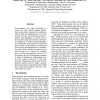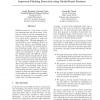153 search results - page 8 / 31 » Better Informed Training of Latent Syntactic Features |
COLING
2010
13 years 2 months ago
2010
Near-synonyms are useful knowledge resources for many natural language applications such as query expansion for information retrieval (IR) and paraphrasing for text generation. Ho...
WSDM
2010
ACM
14 years 4 months ago
2010
ACM
We describe an approach for multi-modal characterization of social media by combining text features (e.g. tags as a prominent example of short, unstructured text labels) with spat...
FSKD
2005
Springer
14 years 1 months ago
2005
Springer
Abstract. In the artificial neural networks (ANNs), feature selection is a wellresearched problem, which can improve the network performance and speed up the training of the networ...
CEAS
2008
Springer
13 years 9 months ago
2008
Springer
Phishing emails are a real threat to internet communication and web economy. Criminals are trying to convince unsuspecting online users to reveal passwords, account numbers, socia...
KDD
2009
ACM
14 years 8 months ago
2009
ACM
Social media such as blogs, Facebook, Flickr, etc., presents data in a network format rather than classical IID distribution. To address the interdependency among data instances, ...


